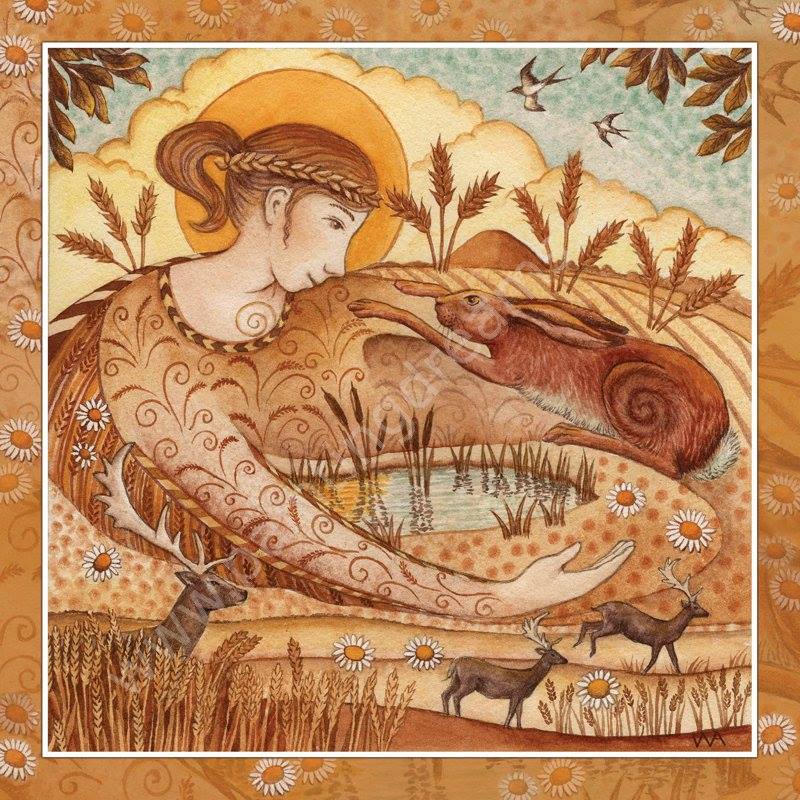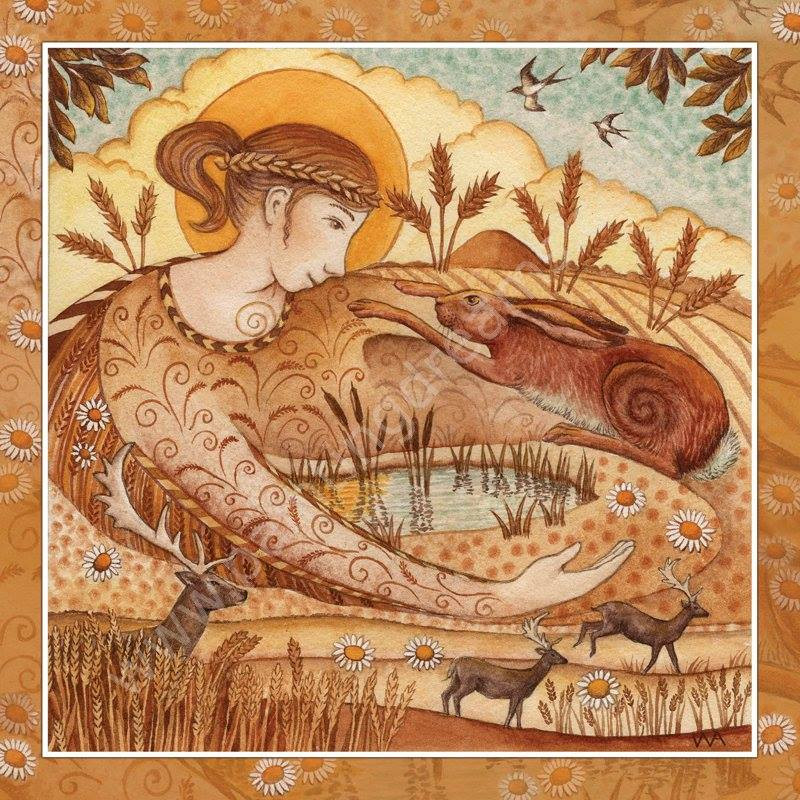Lughnasadh, also known as Lammas, is a pagan holiday celebrated on August 1st in the Northern Hemisphere (or on the corresponding date in the Southern Hemisphere) as one of the four Gaelic seasonal festivals. Rooted in Celtic traditions, Lughnasadh marks the beginning of the harvest season and is named after the Irish god Lugh, a deity associated with skills, craftsmanship, and the harvest.
Lughnasadh holds deep significance as a time to honor the bounty of the earth and express gratitude for the abundance of the harvest. It is a festival that celebrates the agricultural cycle and acknowledges the interconnectedness of humanity with nature's cycles. The holiday represents a time of transition, as the vibrant energies of summer shift towards the harvest and the approach of autumn.
In ancient times, communities would come together to participate in various festivities and rituals during Lughnasadh. These celebrations often included athletic competitions, music, dancing, storytelling, and feasting. The gathering of people fostered a sense of unity and shared appreciation for the blessings of the land.
Lughnasadh is a time to reflect on the fruits of our labor, both literal and metaphorical, and to express gratitude for the abundance that sustains us. It is a moment to acknowledge the cycles of life, growth, and decay, as well as the efforts and skills required for a fruitful harvest. It is also a time to recognize the sacrifices made by the earth and its creatures, as we receive nourishment and sustenance from the natural world.
Modern celebrations of Lughnasadh vary among different pagan and Wiccan traditions. Some may choose to create altars adorned with symbols of the harvest, such as grains, fruits, and vegetables. Rituals and ceremonies may be held to honor the deities associated with Lughnasadh and to express gratitude for the earth's abundance. Offerings may be made, prayers said, and intentions set for the coming season.
Additionally, Lughnasadh can be a time for personal reflection and introspection. It offers an opportunity to contemplate our own personal harvest—our accomplishments, growth, and the lessons learned throughout the year. It's a time to evaluate our intentions and goals, and to prepare for the changes and challenges that lie ahead.
Whether celebrated within a community or in personal solitude, Lughnasadh invites individuals to connect with nature, express gratitude, and celebrate the cycles of life and the interconnectedness of all things. It is a moment to honor the gifts of the earth and to embrace the abundance of the harvest season while looking forward to the coming autumn and the cycles of life that continue to unfold.
How is Lugnasagh Celebrated?
Modern witches and practitioners of Wicca celebrate Lughnasadh, or Lammas, in various ways that resonate with their personal beliefs and traditions. Here are some common practices and rituals that modern witches may engage in during Lughnasadh:
- Harvest Rituals: Lughnasadh is a time to honor the bountiful harvest, and witches may conduct rituals to give thanks for the abundance of the earth. This can involve creating an altar adorned with symbols of the harvest, such as grains, fruits, vegetables, and freshly baked bread. Offerings of gratitude may be made to deities associated with the harvest, such as Lugh or Demeter.
- Outdoor Gatherings: Many modern witches celebrate Lughnasadh in nature, recognizing the connection between the land and the harvest. They may organize outdoor gatherings, picnics, or communal rituals in fields, gardens, or parks. These events often include feasting, storytelling, music, and dancing to honor the spirit of the season.
- Corn Dolly Crafting: Crafting corn dollies is a traditional Lughnasadh activity. Corn dollies are decorative figures made from braided straw or corn husks. They symbolize the fertility and abundance of the harvest. Modern witches may create corn dollies as a meditative or artistic practice, infusing them with intentions and blessings for the coming season.
- Healing and Renewal: Lughnasadh is a time of transition as summer wanes and autumn approaches. Modern witches may engage in rituals and spells focused on healing, transformation, and releasing old patterns. This can involve energy work, meditation, and spellcasting to shed unwanted energies and embrace personal growth.
- Gratitude Practices: Expressing gratitude is a central theme during Lughnasadh. Witches may engage in gratitude rituals or journaling, reflecting on the blessings and abundance in their lives. This can be done by creating gratitude lists, writing thank-you notes to the universe or deities, or participating in group discussions centered around gratitude.
- Herbal Magic: Since Lughnasadh is associated with the abundance of herbs and plants, modern witches may focus on herbal magic during this time. They may gather and dry herbs, create herbal charms or sachets, or perform rituals using the magical properties of plants. This can involve harvesting and utilizing herbs for healing, manifestation, or spellwork.
- Personal Reflection: Lughnasadh is a natural time for personal introspection and assessment. Modern witches may take this opportunity to evaluate their goals, intentions, and achievements over the past months. They may engage in divination practices, such as tarot, rune, or oracle readings, to gain insight into the coming season and to seek guidance for their path forward.
It's important to note that the practices and rituals observed during Lughnasadh can vary among individual witches and pagan traditions. Modern witches often blend their personal beliefs, cultural influences, and spiritual practices to create meaningful and unique celebrations that honor the spirit of Lughnasadh and the cycles of the harvest.

Lughnasadh Correspondences
Correspondences are symbolic associations that align with the energy and themes of a specific holiday or occasion. Here are some common correspondences associated with Lughnasadh:
- Colors: The colors most often associated with Lughnasadh are shades of gold, yellow, orange, and brown. These colors represent the ripening grains, the warmth of the summer sun, and the approaching autumn.
- Symbols: Various symbols are linked to Lughnasadh, including corn dollies, sunflowers, wheat, cornucopias, sickles or scythes, and bread. These symbols represent the abundance of the harvest, fertility, craftsmanship, and the cycle of life.
- Deities: Lughnasadh is named after the Celtic god Lugh, so he is a primary deity associated with this holiday. Other deities often honored during this time include Demeter, Ceres, John Barleycorn, and other harvest and grain deities from different cultural traditions.
- Herbs and Plants: Several herbs and plants have correspondences with Lughnasadh, including grains like wheat and barley, sunflowers, corn, chamomile, lavender, rosemary, and meadowsweet. These plants embody the energies of fertility, abundance, healing, and purification.
- Crystals and Gemstones: Crystals and gemstones that resonate with the energies of Lughnasadh include citrine, amber, peridot, golden topaz, carnelian, and sunstone. These stones are associated with abundance, warmth, vitality, and manifestation.
- Animals: Animals connected to Lughnasadh include bees, butterflies, birds of prey (such as hawks and eagles), and horses. These animals symbolize productivity, transformation, freedom, and strength.
- Elements: The primary elemental correspondences for Lughnasadh are Earth and Fire. Earth represents the fertile soil, the growth of crops, and the abundance of the harvest. Fire represents the transformative power of the sun, the warmth of the season, and the alchemical process of change.
- Activities: Traditional activities and practices associated with Lughnasadh include baking bread, making and displaying corn dollies, harvesting and preserving herbs, creating bonfires or candle rituals, crafting herbal charms, participating in athletic games or competitions, and sharing communal feasts.
These correspondences can serve as inspiration for creating rituals, altar displays, spellwork, and other practices during Lughnasadh. However, it's important to remember that personal intuition and preference should always guide one's correspondences and practices, as each individual's connection to the energies of Lughnasadh may differ.
Must-have Items for your Lughnasadh Altar and Home Decor
Citrine Tumbled Stone
Extra Large Citrine Crystal Point
Energy & Will Pillar Candle
The Sun Tarot Pillar Candle
Herbs and Plants for Lughnasadh:
Chamomile
Lavender
Druid's Crescent Moon Boline
Horned God TealighAltar Statue
Incense and Home Decor for Lughnasadh:
Lughnasadh Incense Sticks: Handmade Gingerbread & Honey Incense
Fire Incense Sticks: Handmade Cinnamon & Heartwood Incense
Jewelry for Lammas Celebration:
Fire Witch Goddess Pendant
Earth Witch Goddess Pendant
(Image by Wendy Andrew of Painting Dreams, UK)

